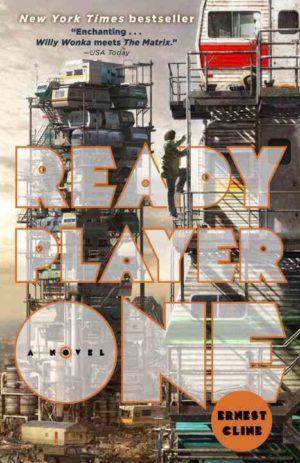 By ERNEST CLINE (Broadway Books; 2011)
By ERNEST CLINE (Broadway Books; 2011)
Here we have what is easily the most popular science fiction novel of the decade. People have been raving about READY PLAYER ONE since it first appeared back in 2011, and now, with the Steven Spielberg directed film adaptation about to be released, it’s once again overtaken the public consciousness. I’ll confess that I (an admitted contrarian) wasn’t too jazzed by the book, which I found shallow, formulaic and far too geeky for its own good.
The overriding subject is pop culture of the 1980s, which Ernest Cline (described in the author bio as a “full time geek”) somehow transposes to the year 2044. Everyone in this future America is obsessed with eighties culture, particularly the geeky teenager Wade Watts. He lives in the stacks, a trailer park whose trailers are stacked atop each other, where he spends his days jacked into a virtual reality universe known as the Oasis. There, in the guise of an avatar named Parzival, Wade attends a virtual school and indulges his passion for all things eighties-related.
He also happens upon a contest willed by one James Halliday, the eccentric creator of the Oasis. Having no heirs, Halliday leaves his fortune to the finder of a specially created “Easter Egg” hidden somewhere in the Oasis, and accessible through a succession of gates. Wade is among the countless Oasis users who go in search of the egg, a quest that takes him through a number of virtual worlds in which his knowledge of all things eighties comes in quite handy (WAR GAMES, BACK TO THE FUTURE, LADYHAWKE, BLADE RUNNER, FAMILY TIES, Max Headroom and nearly the entirety of Atari 2600’s output are all referenced). In the process he runs afoul of The Sixers, a band of corporate scumbags who want to turn the Oasis into a fascist dystopia, and who up the stakes considerably by blowing up Wade’s trailer (luckily he’s not inside when it happens). He also meets Art3mis, a rival player who becomes Wade’s inevitable love interest. Wade ultimately wins the game—a fact made clear in the opening chapter, so that’s not a spoiler—and, of course, learns a valuable lesson.
This is all extremely slickly rendered in easy-to-read first-person prose that doesn’t vex or challenge the reader. That prose was doubtlessly a major component in the novel’s success, as was its wish-fulfillment angle—in fact, I’d say READY PLAYER ONE, with its unabashedly geeky hero, nostalgia-suffused narrative and female lead who functions more as a fantasy than a flesh-and-blood human, is to nerdy gen-Xers what romance novels are to bored housewives. As such it’s quite disposable, which is ultimately my biggest problem with the book; not unlike a Hollywood blockbuster of the type it’s been adapted into, it leaves very little mark on the reader. Plus, I found that the constant eighties shout-outs, while initially charming, grow quite annoying—as one early reviewer said of the movie adaptation, there are just “too many references for the mainframe.”
